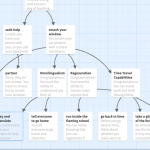5.4 Task 5: Twine Task

My Super Power Twine: file:///Users/kewong/Downloads/My%20Super%20Power.html
This was my first time using Twine and I thought it was fun and made stories adventurous. I really like the concept of giving the reader some autonomy in deciding how a story might play out. It certainly reminded me of those “Choose Your Own Adventure” books that I used to read as a child. The “cheat sheet” that was provided really helped. Once I became more familiar with how to input text and images, I tried to focus more on my story and the purpose of what I wanted to achieve. In consideration of the reader, I had to think about what choices and paths I could offer as possibilities. In chapter 3 of Writing Space: Computers, Hypertext, and the Remediation of Print, Bolter (2001), he says that the choices can be equally convincing and the hypertext suggests the changed relationship between the reader and the text. As I continued to create my Twine, I wasn’t thinking about the relationship of the reader and the text itself. I was thinking about the relationship of the reader and the story. How can I make this meaningful with just a few words…hypertext.
As a creator using Twine, I found it much easier to write using hypertext, as series of text chunks (Wright, 2007) which give links to offer the reader different pathways as Ted Nelson defines this in the YouTube clip in this Week’s module 5, The Web that Wasn’t by Alex Wright. It was easier than writing a whole story and giving details to the plot and characters. It gave me the opportunity to be concise and deliberate with the options I was giving the reader. There was unnecessary text. The hypertext gave a clear and direct communication to the reader to either [[do this]] or [[do that]] which I found efficient and organized.
Jay Bolter (2001) describes literature as an ongoing system of interconnected documents. I felt that Twine was very much like Bolters (2001) description where all the web of connections and written options are connected to the story and readers decisions. Using Twine, gives the reader choices uses the hypertext links to make decisions that control the outcome of the story. Bolter (2001) says that there are connections with the hypertext that are meaningful for the author and the reader depending on what is their chosen path in the text. When humans meet a dilemma in their life, there is often a divide of choices. Twine gives the reader the opportunity to choose a particular route in order to fulfill a certain outcome and looks at the variety of possibilities. Bolter (2001) mentions that readers get to participate in several paths and the significance will depend on the readers choice to arrive at the next topic. As I continued to create my story, I kept thinking about how I could make my choices significant to the reader.
I’m beginning to think more about how text and language give meaning. In the podcast, The Allusionist, Gretchen McCulloch talks about how punctuation in text gives meaning. For example, a “period” can mean sincerity but could also be implied as rude. Will the students in my class lose the meaning of how words can be used to express certain things? A time where emojis and GIFS are vastly used to communicate. I often find that my students have so much difficulty expressing themselves or knowing what to write. It seems to be all of my students when it comes to writing assignments. I feel it is my duty as an educator to ensure that students are enjoying text and writing meanwhile using technology. I think my next assignment for my students will be to work collaboratively and use the idea of Twine and hypertext. They can brainstorm some opportunities for choices (paths) and work together to expand their ideas as to what consequences will occur if they choose a certain pathway. It could be much more detailed in description. I hope they can see this as something fun and use it to expand their written skills!
References
Bolter, J.D. (2001). Writing Space: Computers, hypertext, and the remediation of print (Links to an external site.). Mahway, NJ: Lawrence Erlbaum Associates, pp. 77-98.
Wright, A., [Google Tech Talks] .(2007, Oct 26). The Web that Wasn’t [Video].YouTube
https://www.youtube.com/watch?v=72nfrhXroo8&feature=emb_title
Zaltzman, H. (Host). (2019, July 13). New rules (No. 102) [Audio podcast episode]. In The Allusionist. https://howitbegan.com/episodes/the-printed-book/